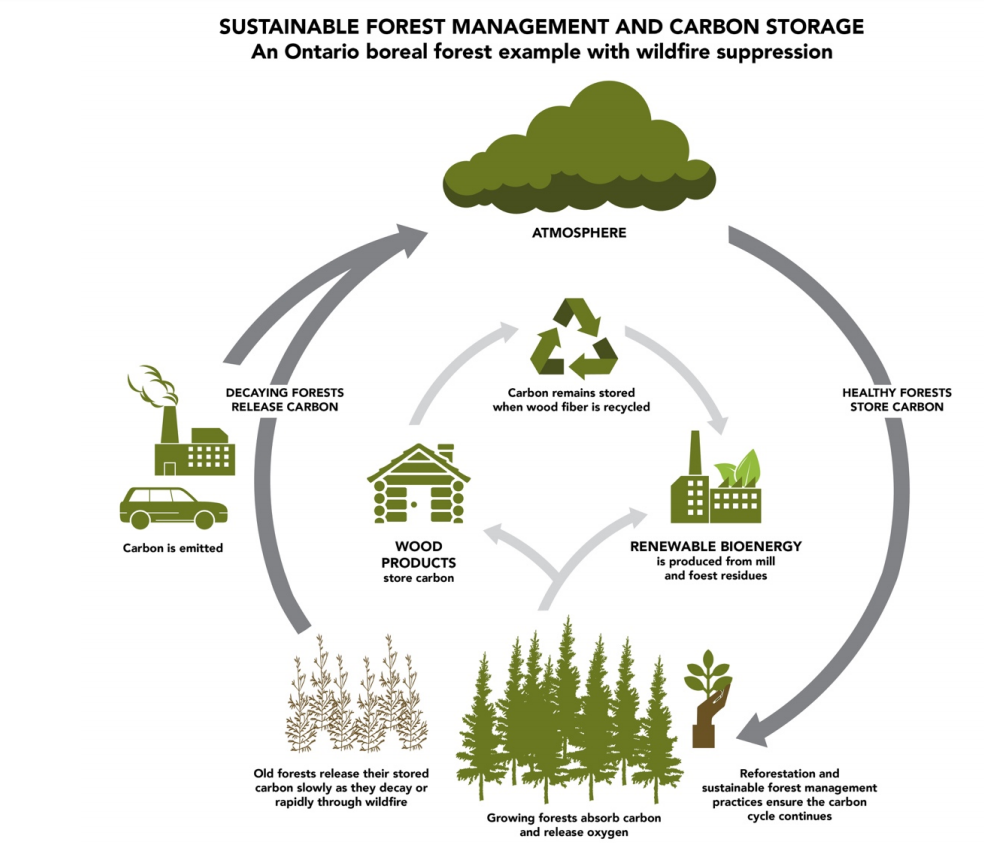Managed forests and climate change
Learn about how the province’s managed forests can help address the effects of climate change.
Climate change and forests
Scientific evidence suggests that climate change could impact the province’s natural resources, including forests, causing:
- changes in forest growth due to climate warming and changes in precipitation
- changes where tree species can grow
- extreme weather events, wildfires and other natural disturbances
Managing Ontario’s forests sustainably can help address the effects of climate change.
Addressing climate change
As outlined in the Made-in-Ontario Environment Plan, Ontario is committed to addressing climate change and to reducing our greenhouse gas emissions to 30% below 2005 levels by 2030, a target that aligns with the federal government's commitments to the Paris Agreement.
The ministry plays an important role in helping the province meet its commitments under both the Made-In-Ontario Environment Plan and Sustainable growth: Ontario’s forest sector strategy.
The ministry is addressing climate change in forests by:
- supporting forest managers to further reduce emissions and increase carbon storage in forests and harvested wood products
- using adaptive management practices to help forests adapt to climate change
- exploring approaches to forest carbon and climate change considerations in forest management
Understanding climate change
The ministry works with agencies and partners such as the Canadian Forest Service, Canadian Council of Forest Ministers, and colleges and universities on research studies and projects to help understand climate change and its effect on forests .
Research topics involving Ontario’s forests include:
- climate change and the future fire environment in Ontario
- carbon management and storage in Ontario’s forests
- climate change and biodiversity in Ontario
- climate change and impacts on Ontario’s forests and forestry
- climate change and spruce budworm
Mitigating climate change
Trees play an important role in moderating impacts associated with climate change. They absorb carbon dioxide from the air and store carbon.
Trees, like all green plants, photosynthesize as follows:
- absorb carbon dioxide from the air
- break the carbon dioxide into oxygen and carbon
- oxygen is released back into the air
- carbon is stored in leaves, stems, roots and flowers (called carbon sequestration)
Trees are particularly good at storing carbon because they:
- are about 50% carbon
- live for a long time
- rot slowly, particularly in cool climates like Ontario
Generally, the faster and longer trees grow, the more carbon they absorb and store.
Forests and carbon storage
- Forests sequester and store carbon (temporarily) in trees, soil and organic matter
- Carbon is also stored in harvested wood products
- Older forests contain more total carbon but the rate of sequestration is slow and outweighed by losses of carbon from trees dying and decomposing
- Young forests contain less total carbon but they sequester carbon at a faster rate than older forests.
- Carbon is also emitted from forests through natural disturbances such as fire, insects, disease, and wind.
Mitigation activities
To reduce greenhouse gases and mitigate climate change we:
- apply sustainable forest management practices
- further increase carbon storage by sustainably harvesting forests and storing carbon in longer-lived wood products
- adapt management practices to enable productive and resilient forests into the future
- make information available on the mitigation potential of Ontario’s forest sector
- estimate the costs of mitigation in Ontario’s forest sector
Applying forest management practices
Management decisions that maintain healthy and diverse forests are a key strategy for retaining a resilient forest that can endure many threats, including climate change.
Applying forest management practices to encourage forest growth and productivity (PDF) may also result in opportunities to increase carbon sequestered in forests.
The ministry’s forest management policies allow for strategies and practices to sequester carbon in forests and harvested wood products.
Forest carbon offset projects that reduce greenhouse gas emissions to compensate for an emission made elsewhere may also result in enhanced greenhouse gas removals from the atmosphere.
Increasing carbon storage in forests
Urban development, highway construction and agriculture all lead to deforestation. In Ontario’s managed Crown forests, new trees are grown in areas where trees have been harvested. For this reason, harvested and regenerated areas are not considered deforested.
Healthy forests absorb carbon. We can store more carbon in our forests by:
- sustainably managing Ontario’s forests
- growing more trees
- growing healthy trees faster and longer
- restoring damaged and degraded forests
- directing harvested wood into longer-lasting wood products
Carbon storage in wood products
Forest products like lumber, telephone poles and furniture can store carbon for centuries. The life-cycle of a harvested wood product:
- starts with forest harvesting
- ends when the wood product fully decomposes or is combusted
We have developed, updated and published life-cycle analysis for Ontario forest products.
In some cases, using wood products as substitutes for more energy-intensive building materials like concrete or steel can significantly reduce greenhouse gas emissions.
In 2015, Ontario’s managed Crown forests stored an estimated 4.3 billion tonnes of carbon. An additional 170.5 million tonnes of carbon were stored in wood products.


Wood as renewable heat and energy
Wood as a renewable energy source can reduce greenhouse gas emissions over time. Using forest biofibre and by-products from mill operations to generate energy (for instance, heat and electricity) can mean an overall reduction in long-term carbon emissions when it replaces carbon-intensive fossil fuels in rural and remote communities.
The forest products industry also uses forest biofibre, mill by-products and residues such as bark, shavings and sawdust to generate approximately 60% of the total energy used in wood product production.
Wildland fires in Ontario’s boreal forest
The boreal forest is a fire-dependent ecosystem. Following a wildland fire, new vegetation begins to grow. As a boreal forest ages in the absence of fire or other disturbances, some landscapes can become more prone to the potential of larger fires that are difficult to control. These large wildland fires can release significant amounts of greenhouse gas emissions. In some longer and more severe fire seasons, carbon emissions from wildland fires can equal the annual carbon emissions from burning fossil fuels across the country.
Emissions from wildland fires vary dramatically based on:
- the type of forest
- the size and intensity of the fire
- other factors
Allowing monitored wildland fires to burn under low risk conditions can help prevent future extreme wildland fires in the same area. The way in which natural resources are managed can also influence the balance of greenhouse gases, where sustainable forest management activities mimic natural disturbances and can enhance carbon storage.
Adaptive forest management
Research and adaptive management practices, which means making decisions and adjusting practices based on current knowledge and monitoring, show us how climate change affects forests.
To help Ontario’s forests adapt to climate change we:
- review forest legislation and policy to determine if and how it can be enhanced
- develop methods to assess the vulnerability of forests
- maintain a healthy and diverse forest that is able to adapt to a changing climate
- develop models of climate change impacts on forests to assist in the modification of forest management practices
- incorporate climate change considerations into forest management planning
- revise manuals, guides and plans to provide new direction as new evidence becomes available
- modify the scheduling and availability of forest firefighting resources as required in response to potential changes in fire season length and severity
Tree planting
Planting trees can store carbon and provide many other benefits.
Planting large numbers of trees will:
- increase the general amount of forest cover
- restore abandoned agricultural land that will support diverse, naturally regenerating forests in the future
- connect existing natural spaces to facilitate movement for plants and animals
- increase the amount of wildlife habitat including habitat for species at risk
- conserve biodiversity
- conserve soil and water
- moderate local climates by providing shade, moderating temperature extremes and reducing the effects of storms
- boost local economies by providing work for seed collectors, nurseries and companies that plant and tend trees
- provide timber for wood products
- support economic development and create opportunities for outdoor recreation
How you can act on climate change through forests
There are many ways you as an individual or organization can help reduce the impacts of climate change through forests, including:
- learn how to apply for the Land Stewardship and Habitat Restoration Program and Managed Forest Tax Incentive Program
- learn to manage your woodlot in a changing climate
- choose sustainably-grown Ontario wood building materials
